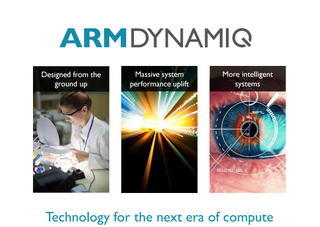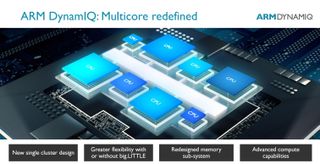The Next 100 Billion ARM-Powered Devices Will Feature ARM DynamIQ Technology

ARM revealed a new multicore microarchitecture called ARM DynamIQ designed to improve the efficiency and performance of ARM Cortex-A processors and offers increased flexibility for use in a variety of cases including autonomous cars, artificial intelligence, and mixed reality devices.
ARM is preparing a new generation of microprocessors, and the company expects to sell a whole lot of them. The company said that its microprocessor sales are growing at a rapid pace, and it expects the see the acceleration continue. For a long time, ARM’s products were used to power feature phones, which allowed the company to sell 1 billion units in the first 10 years, but that’s peanuts compared to ARM’s sales volume today.

The ubiquity of smartphones and other such devices enabled incredible growth for the company. In a briefing with Tom’s Hardware, Nandan Nayampally, General Manager, ARM Compute Products Group, explained that between 1991 and 2013, the company shipped 50 billion units. By 2005, ARM was producing a billion units per year, and by 2009 the company was shipping a billion units every quarter.
Even so, the company expects to accelerate its output over the next four years. To date, ARM has 100 billion units in the market; by 2021, the company expects to have shipped 100 billion more.
To ship 100 billion microprocessors in the next four years, the demand for ARM’s chips must continue to grow at an exponential rate. ARM isn’t concerned about how to attract that demand. The company is widening its reach into emerging markets that will continue to demand rapid innovation, such as the artificial intelligence (AI) and autonomous automobile industries. As automation, machine learning (ML), and AI rapidly advance, the need for faster, low-powered processors will only increase.
The same can be said for the AR/VR/MR (read: XR) markets for both smartphones and standalone devices. We’re in the early days of the XR revolution, and our collective imagination is the limit for where immersive technology will eventually take us in the future, but performance and power consumption are two issues that will continue to hold XR back in the meantime.
ARM is no stranger to efficiency advancements. In 2011, the company introduced big.LITTLE technology, which allowed vendors to pair two CPU clusters of differing sizes to handle low powered tasks more efficiently and to free up resources for tasks with higher demands. ARM’s big.Little technology promised CPU power savings of up to 75%.
Stay on the Cutting Edge
Join the experts who read Tom's Hardware for the inside track on enthusiast PC tech news — and have for over 25 years. We'll send breaking news and in-depth reviews of CPUs, GPUs, AI, maker hardware and more straight to your inbox.

ARM’s DynamIQ multicore microarchitecture builds on the idea of using differently sized processors for different tasks and allows for greater flexibility by supporting big and LITTLE processors in the same cluster.
“With the two cluster system on big.LITTLE we could mix and match different performance processors, but still each cluster was targeted for a particular performance level,” said Nayampally. “Now, there’s a substantially greater level of flexibility in the DynamIQ cluster because now you have multiprocessing of all different types of processors—different performance points, different power points—all in the same cluster.”
DynamIQ clusters are designed to offer faster task switching and better task matching than previous generation ARM processor clusters, and DynamIQ technology lets vendors define specific power and performance characteristics of up to eight individual CPUs per cluster. Each processor in a DynamIQ cluster operates at different frequencies to help limit the thermal output while maximizing performance where it's needed. DynamIQ technology also offers advanced automatic memory management that powers only the memory banks needed at any given time. The memory management technology should improve performance while increasing battery life in portable devices.

ARM DynamIQ technology also features dedicated instructions for ML and AI, which “can be optimized to deliver up to a 50x boost in AI performance over the next 3-5 years relative to Cortex-A73-based systems today,” according to ARM. The instruction set includes optimizations that improve the response between the CPU and specialized accelerator hardware on the SoC.
The autonomous car industry should be excited about ARM DynamIQ technology, too. ARM designed it to help improve the response time of advanced driver assistance systems (ADAS) in modern vehicles. ARM said DynamIQ technology enables partners to build automotive safety level D (ASIL-D) compliant systems for autonomous vehicle control. ASIL-D is the highest classification of injury risk, and compliance requires that systems remain operational under failure conditions.

This is all, though, quite a high-level look at DynamIQ technology. ARM said that you could expect technical details in the coming months. ARM DynamIQ technology will make its debut in an upcoming Cortex-A processor, which we’ll learn more about later this year.
Kevin Carbotte is a contributing writer for Tom's Hardware who primarily covers VR and AR hardware. He has been writing for us for more than four years.
-
sadsteve I didn't think ARM actually built and sold ARM based chips. Every ARM processors I've used were built by companies that licensed the ARM designs. Like Broadcom, TI, NXP, etc.Reply -
Sounds great, but we'll see how it works in practice. The tri-clusters (helio) are having problems switching efficiently, if/when we have 4+ different core models, will they really beat big.LITTLE in power efficiency.Reply
-
JamesSneed Reply19455969 said:I didn't think ARM actually built and sold ARM based chips. Every ARM processors I've used were built by companies that licensed the ARM designs. Like Broadcom, TI, NXP, etc.
This struck me odd as well. You are right ARM only makes the designs. The way this copy paste pres release from ARM reads its as though they are actually manufacturing the chips but they are not.
"ARM is preparing a new generation of microprocessors, and the company expects to sell a whole lot of them."
Might restate this so its not so misleading as they are not selling microprocessors, they are only licensing the IP. -
aldaia ARM makes money in two ways. It charges an upfront license fee and also a royalty. The royalty is on a per chip basis. Every chip that contains ARM IP has a royalty associated with it. The royalty is typically 1 - 2% of the selling price of the chip.Reply
Even if ARM dosn't actually buids chips, the statement that "the company expects to sell a whole lot of them." is still valid. -
JamesSneed Reply19456737 said:ARM makes money in two ways. It charges an upfront license fee and also a royalty. The royalty is on a per chip basis. Every chip that contains ARM IP has a royalty associated with it. The royalty is typically 1 - 2% of the selling price of the chip.
Even if ARM dosn't actually buids chips, the statement that "the company expects to sell a whole lot of them." is still valid.
"ARM is preparing a new generation of microprocessors, and the company expects to sell a whole lot of them."
Them refers to microprocessors being sold, so no its not valid. I wast trying to nit pick it is just misleading. I had to go to ARM's site to see if they are making chips....
-
bit_user Reply
You're really splitting hairs, here.19457045 said:Them refers to microprocessors being sold, so no its not valid. I wast trying to nit pick it is just misleading. I had to go to ARM's site to see if they are making chips....
I actually expected someone to jump on the way he's talking about "shipping units". Because "shipping" implies something very physical and it's their customers who do the actual shipping of actual units.
Anyway, I'm a bit disappointed by this big announcement that seems like it boils down to "hey, now you can mix cores within a cluster!". I know there's slightly more to it, than that.
I'm interested in seeing what smarts they put into improving the power-efficiency of their cache hierarchy. I've read that the cache hierarchy is a big power sink. If they can start pulling memories closer to the clusters, via stacking and in-package interposers, then perhaps they'll actually flatten the cache hierarchy a bit. -
bit_user Reply
Why?19458525 said:Something about this is how you get skynet.
This article makes only a passing reference to machine learning or AI. I think the new architecture has very little to do with faster AI, and it's really the AI accelerators they building (that happen to fit within it) that will deliver the improvements. -
JamesSneed Reply19459049 said:
You're really splitting hairs, here.19457045 said:Them refers to microprocessors being sold, so no its not valid. I wast trying to nit pick it is just misleading. I had to go to ARM's site to see if they are making chips....
I actually expected someone to jump on the way he's talking about "shipping units". Because "shipping" implies something very physical and it's their customers who do the actual shipping of actual units.
Anyway, I'm a bit disappointed by this big announcement that seems like it boils down to "hey, now you can mix cores within a cluster!". I know there's slightly more to it, than that.
I'm interested in seeing what smarts they put into improving the power-efficiency of their cache hierarchy. I've read that the cache hierarchy is a big power sink. If they can start pulling memories closer to the clusters, via stacking and in-package interposers, then perhaps they'll actually flatten the cache hierarchy a bit.
You say I'm nit picking but then go on to add to my case. :)
I had just picked one thing to point at and yes the shipping thing bothered me as well. I think the author of this article is very confused as other companies built processors based on ARM's design. ARM didn't make, ship or sell any actual physical item.
I agree this is mostly a pre-announcement saying we are working on this new thing that we called DynamicIQ that will allow you to mix big.little cores more granularity like say 1 big and 7 little etc. There is a bit more to it but that was the larger take way the rest is performance related and as such with no working product can be mostly ignored.
-
bit_user Reply
I think he gets it and was just using the terminology from the slides. Anyway, no one here seems confused. When I said you were splitting hairs, that was about your comment/downvote of @aldaia.19460751 said:I think the author of this article is very confused as other companies built processors based on ARM's design. ARM didn't make, ship or sell any actual physical item.
Most Popular






